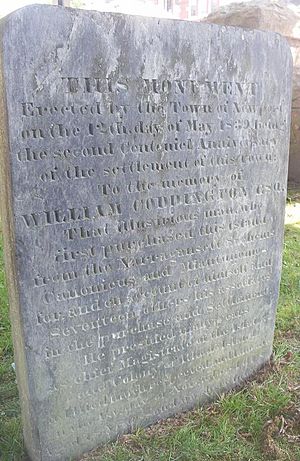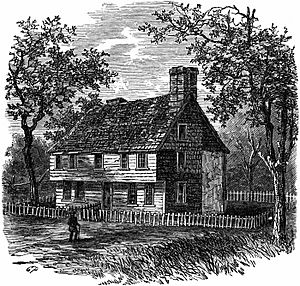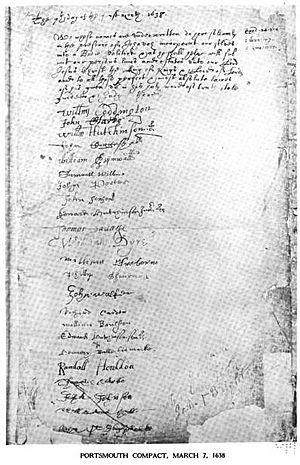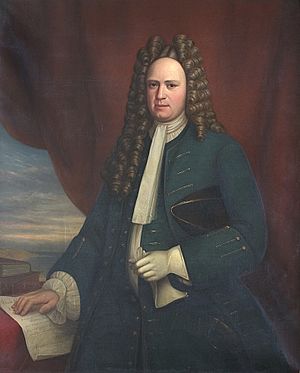William Coddington facts for kids
Quick facts for kids
William Coddington
|
|
|---|---|

Memorial marker for William Coddington dedicated on 200th anniversary of Newport founding
|
|
| 1st Judge (governor) of Portsmouth | |
| In office 1638–1639 |
|
| Preceded by | position established |
| Succeeded by | William Hutchinson |
| Judge (governor) of Newport | |
| In office 1639–1640 |
|
| Preceded by | position established |
| Succeeded by | Himself as governor of Newport and Portsmouth |
| Governor of Newport and Portsmouth | |
| In office 1640–1647 |
|
| Preceded by | William Hutchinson as Judge of Portsmouth Himself as Judge of Newport |
| Succeeded by | John Coggeshall as President of Rhode Island |
| 1st Governor of Newport and Portsmouth (under Coddington Commission) | |
| In office 1651–1653 |
|
| Preceded by | Nicholas Easton as President of Rhode Island |
| Succeeded by | John Sanford |
| 5th and 8th Governor of the Colony of Rhode Island and Providence Plantations | |
| In office 1674–1676 |
|
| Preceded by | Nicholas Easton |
| Succeeded by | Walter Clarke |
| In office 1678–1678 |
|
| Preceded by | Benedict Arnold |
| Succeeded by | John Cranston |
| 7th Deputy Governor of the Colony of Rhode Island and Providence Plantations | |
| In office 1673–1674 |
|
| Governor | Nicholas Easton |
| Preceded by | John Cranston |
| Succeeded by | John Easton |
| Personal details | |
| Born | c. 1601 Marston, Lincolnshire, England |
| Died | 1 November 1678 Newport, Rhode Island |
| Resting place | Coddington Cemetery, Newport, Rhode Island |
| Spouses |
|
| Occupation | Merchant, treasurer, selectman, assistant, president, commissioner, deputy governor, governor |
| Signature | |
William Coddington (born around 1601 – died November 1, 1678) was an important leader in the early American colonies. He first served as a judge in the Massachusetts Bay Colony. Later, he became a key figure in the founding and leadership of the Colony of Rhode Island and Providence Plantations. He held many important roles, including judge, deputy governor, and governor of the colony.
Coddington was born and grew up in England. In 1630, he sailed to New England with the Winthrop Fleet, a group of ships carrying early settlers. He quickly became a leader in Boston, where he built the first brick house and was involved in the local government.
Coddington was part of the Boston church. He became involved in a big disagreement called the Antinomian Controversy (1636-1638). This led to some people, like Anne Hutchinson, being forced to leave Massachusetts. Coddington felt this was unfair, so he decided to leave too. He and other supporters signed an agreement to start a new Christian-based government away from Massachusetts.
Roger Williams suggested they settle near Narragansett Bay. Coddington and others bought Aquidneck Island from the Narragansett Indians. They started a town called Pocasset, later known as Portsmouth. Coddington was chosen as the first "judge," which was like a governor.
After a disagreement, Coddington and some others left Portsmouth. They started a new town called Newport at the south end of the island. Soon, Portsmouth and Newport joined together, and Coddington became governor of the island towns from 1640 to 1647.
Later, Roger Williams got a special document from England to unite all four towns in the area: Providence, Warwick, Portsmouth, and Newport. Coddington didn't like this idea because he wanted the island towns to be separate. He even went to England himself and got a special permission, called a "commission," to govern the island towns independently.
At first, people welcomed him as governor under this new commission. But soon, people from both the island and mainland towns complained. So, Roger Williams and others went back to England to have Coddington's special permission taken away. They succeeded, and the towns reunited in 1654.
After this, Coddington stepped away from public life for a while and became a member of the Religious Society of Friends (Quakers). Nearly 20 years later, he returned to politics. He was elected deputy governor in 1673 and then governor in 1674, serving two one-year terms. During his second term, a major conflict called King Philip's War started in June 1675. This was a very difficult time for the colony.
Coddington was not re-elected in 1676. However, he was elected governor one last time in 1678 after the previous governor died. He passed away a few months into this term, on November 1, 1678. He was buried in the Coddington Cemetery in Newport.
Contents
Early Life in England
William Coddington was born in Lincolnshire, England, around 1601. His parents were likely Robert and Margaret Coddington. His father was a successful farmer. William Coddington seemed to be well-educated, even though we don't know where he went to school. We can tell this from his letters and his good understanding of English law.
Around 1626, he got married. He had two sons who were baptized in St. Botolph's Church in Boston, Lincolnshire. Sadly, both sons died as babies and were buried there. His first wife was named Mary.
In 1626, King Charles I tried to raise money without Parliament's approval. Many Puritans, including Coddington, refused to pay this "Forced Loan." His name was on a list of those who resisted.
Moving to Massachusetts
Coddington was chosen as a leader (called an assistant or magistrate) for the Massachusetts Bay Colony in March 1630, while he was still in England. He sailed to New England the next month with the Winthrop Fleet. His first wife died during their first winter in Massachusetts.
He went back to England in 1631 and stayed for two years. During this trip, he married Mary Moseley. She came back to New England with him in 1633. She joined the Boston church that summer.
Coddington became a very important merchant in Boston. He built the first brick house in the town. He was elected as an assistant every year from his arrival until 1637. He also served as the colony's treasurer from 1634 to 1636. In 1637, he was a representative for Boston. He was also a town leader (selectman) in Boston in 1634.
Founding Rhode Island
Coddington was upset about some unfair trials that had happened in Massachusetts. He started planning to leave the colony with others who felt the same way. He talked with Governor John Winthrop, who encouraged him to leave peacefully.
They weren't sure where to go. So, they contacted Roger Williams, who suggested they buy land from the Narragansett Indians near his settlement in Providence.
On March 7, 1638, a group of men met at Coddington's house. They wrote an agreement, sometimes called the Portsmouth Compact. Many of these men had supported Anne Hutchinson and had been punished or told to leave Massachusetts. Others who weren't directly involved also joined them.
About 23 people signed this agreement. It was meant to create a "Bodie Politick" (a government) based on Christian ideas. Coddington was the first to sign and was chosen as their "Judge," a Biblical term for a ruler or governor. They bought Aquidneck Island (which they called Rhode Island) and started their colony. They first named the settlement Pocasset, but soon changed it to Portsmouth.
The Split and Union
Within a year, there were disagreements among the leaders in Portsmouth. Coddington and some others moved to the south end of the island. There, they started the town of Newport. In 1640, the two towns of Portsmouth and Newport united. The leader's title was changed to governor, and Coddington was elected.
The island towns grew much faster than the mainland settlements of Providence Plantations and Warwick. Roger Williams wanted all four settlements on Narragansett Bay to be under one government. So, he went to England and got a special document, called a "patent," in March 1644. This patent was meant to unite all four towns.
Coddington did not like Williams' patent. He believed the island towns had a well-organized government that was different from the less organized mainland towns. Because of this, the island towns ignored the patent for a while. They even officially named their island "Rhode Island" in April 1644. Coddington was so unhappy that he wrote a letter saying he would rather join Massachusetts or Plymouth than Providence. However, the island towns finally agreed to join the larger colony in 1647. That same year, Coddington's second wife, Mary, died in Newport.
In May 1648, Coddington was elected president of the entire united colony. But he didn't attend the meeting, probably because he still didn't support the patent. He was later replaced by Jeremy Clarke.
Coddington's Special Commission
Feeling frustrated, Coddington decided to go to England to present his case. He wanted the island towns to be independent. He arrived in England during a civil war, which delayed him. He eventually met with Sir Harry Vane, who had helped Roger Williams get his patent earlier.
On March 6, 1650, Coddington asked for a separate government for Rhode Island (Portsmouth and Newport) and the nearby island of Conanicut. In April 1651, the English government gave Coddington this special permission, or "commission." This made him governor of the islands for an unlimited time, as long as Parliament agreed. Vane agreed to this, which meant Roger Williams' earlier patent was put aside.
Coddington spent almost three years in England. While there, he married Anne Brinley. Her brother, Francis Brinley, later moved to Newport and built a large building that became the White Horse Tavern. In August 1651, Coddington returned to the island. Many people welcomed him and accepted him as governor.
Some historians have different opinions about Coddington's actions. Some believe he was wrong to try and separate the island, while others think he was justified because the island towns were doing well on their own.
Commission Revoked
Soon, people started to criticize Coddington. Dr. John Clarke and William Dyer were sent to England to get Coddington's special commission taken away. At the same time, Roger Williams went to England for the mainland towns with the same goal.
The three men met with the English government in April 1652. Coddington was accused of siding with the Dutch in trade matters. In October 1652, his commission for the island government was taken away. William Dyer brought the news back to Rhode Island in February 1653. The colony was supposed to reunite, but disagreements continued for another year. During this time, John Sanford was elected governor of the island towns, and Gregory Dexter became president of the mainland towns. Coddington, now without power, stepped away from public life to focus on his businesses.
The four towns finally united in 1654. Nicholas Easton of Newport was chosen as president. Later, Roger Williams was elected president and served for almost three years. Coddington slowly returned to public life. An investigation cleared him of any past complaints. In March 1656, he finally accepted the united government of the four towns.
Later Leadership and War

Around the early 1660s, Coddington, along with Governor Nicholas Easton and many other important citizens, became members of the Religious Society of Friends, also known as Quakers.
Coddington stayed out of public office for nearly 20 years after his special commission was taken away. However, he was still seen as one of the colony's most important citizens. His name is even listed in the Royal Charter of 1663, which was a very important document for the colony.
He returned to serving the colony in May 1673, when he was elected deputy governor under Governor Nicholas Easton. A year later, in May 1674, he was chosen as governor. John Easton, Nicholas's son, was elected deputy governor. During this time, peace was made between England and the Dutch, which reduced tension in the colonies. Also, the town of Kingston was established.
In May 1675, Coddington was re-elected governor. But the peace was broken in June 1675 when an attack at Swansea started King Philip's War. This was the most damaging event in Rhode Island's history before the American Revolution. Many mainland settlements were destroyed, but the island towns of Newport and Portsmouth were protected by armed ships.
In the 1676 election, Walter Clarke was elected governor, and his time in office saw the end of the war. Benedict Arnold became governor in 1677. He died a year later, and Coddington was elected to his final term as governor in 1678. He died just a few months into this term, in November 1678.
Family and Legacy
William Coddington died on November 1, 1678, while still in office. He is buried in the Coddington Cemetery in Newport, Rhode Island, where several other colonial governors are also buried. His grave has its original marker, plus a taller monument put up on the 200th anniversary of Newport's founding.
His oldest son, William Coddington, Jr., who was born to his third wife, Ann Brinley Coddington, also became governor of the colony for two terms (1683-1685). His son Nathaniel married Susanna Hutchinson, who was a granddaughter of Anne Hutchinson. His daughter Mary married Peleg Sanford, who was a colonial governor from 1680 to 1683. Peleg was also a grandson of Anne Hutchinson.
Coddington often disagreed with Roger Williams. Williams once described him as "a worldly man, a selfish man, nothing for public, but all for himself and private." However, historians also describe Coddington as a very smart and determined person.
Today, several places are named in his honor. Coddington Hall at the University of Rhode Island is named after him. A harbor, a street, a cemetery, and an apartment complex in Newport also bear his name. The Coddington Brewery restaurant in Middletown, Rhode Island is also named for him.
Images for kids



